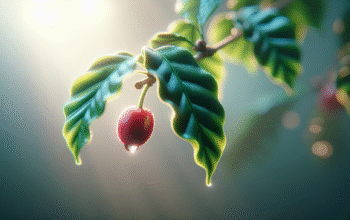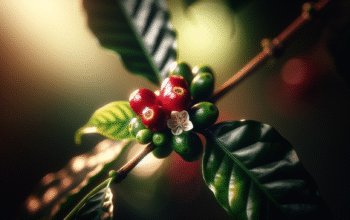?Have you ever wondered whether the coffee beans you brew go through a fermentation process, and what that means for the cup you taste?
Are coffee beans fermented
You may be surprised to learn that most coffee beans do go through a form of fermentation as part of post-harvest processing. That fermentation is not always the dramatic bubbling you might imagine from wine or kombucha, but it is a biochemical and microbial set of processes that significantly shapes flavor, aroma, and quality.
What is fermentation?
Fermentation is broadly the transformation of organic compounds—usually sugars—by enzymes and microorganisms into acids, alcohols, gases, and other metabolites. In coffee, fermentation typically refers to the breakdown of the mucilage (the sticky sugar-rich layer) that surrounds the bean (seed) inside the coffee cherry, and it can also include other microbially mediated chemical changes inside the bean.
Microbial fermentation vs enzymatic processes
You should know that both microbes (yeasts, bacteria) and endogenous enzymes (naturally present in the fruit and bean) participate in fermentation-like reactions. Microbial activity often complements or accelerates enzyme-driven breakdown of sugars, pectins, and other compounds in the mucilage and sometimes in the bean itself.
Why fermentation matters in coffee
Fermentation influences acidity, sweetness, body, and a wide range of aroma and flavor precursors that affect the final roast and cup. If you follow specialty coffee, you’ll notice producers intentionally manipulate fermentation to achieve preferred flavor profiles or to create novel and experimental cups.
Do coffee beans undergo fermentation?
Yes—at least in almost all common processing methods, coffee seeds experience biochemical changes that qualify as fermentation. The extent, microbiology, and purpose of fermentation vary by processing style, farm practices, and environmental conditions.
Where in the process fermentation happens
Fermentation usually happens after cherries are harvested and after pulping (removing the skin and pulp) when mucilage remains on parchment coffee, or during drying when cherries are left intact. The timing may be immediate or delayed, and some methods (natural/dry processing) subject whole cherries to extended time where microbial and enzymatic changes occur.
Is coffee fermentation the same as fermentation of other foods?
It’s similar in that microbes transform sugars and generate acids, alcohols, and aroma compounds, but coffee fermentation is unique in its substrates (mucilage, pectin, and the coffee seed) and in the desired outcomes. You shouldn’t assume coffee fermentation produces the same products or safety considerations as fermented foods like yogurt or sauerkraut.
Coffee processing methods and fermentation
Processing method determines when and how much fermentation occurs, and so the method is a primary lever you can use to predict the kinds of flavors that will develop. Below you’ll find descriptions of common methods and how fermentation is incorporated into each.
Washed (wet) processing
Washed processing starts with removing skin and pulp, then uses fermentation tanks to break down mucilage on the parchment coffee. You will often find the fermentation time ranges from 12 to 72 hours depending on temperature and the producer’s goals, with the aim of producing bright, clean acidity.
Natural (dry) processing
Natural processing leaves cherries intact and dries them with the mucilage and skin still on the seed, enabling long periods of microbial action directly on the fruit. You should expect more fruity, fermented, or “wild” flavors from naturals because the entire cherry interacts with microbes during slower drying.
Honey (pulped natural) processing
Honey processing removes the skin and part of the pulp but leaves varying amounts of mucilage on the parchment; the name “honey” refers to sticky mucilage, not to actual honey. Fermentation of the remaining mucilage plays a large role in shaping sweetness and body, and producers classify “white,” “yellow,” “red,” and “black” honey according to drying times and mucilage quantities.
Anaerobic fermentation
Anaerobic fermentation is performed in sealed tanks with limited oxygen, often under controlled temperatures and for deliberate durations. You’ll find this method produces distinct fruit-forward and sometimes novel flavors because anaerobic microbial communities favor different metabolic pathways.
Semi-washed (wet-hulled, Giling Basah)
This method, common in Indonesia, involves partial washing and then removing parchment at higher moisture contents, causing fermentation and rapid drying to produce a heavy, earthy, and sometimes savory cup. You should be aware that semi-washed processing produces very particular and regionally valued flavors but is less common in specialty coffee outside certain origin countries.
Table: Common processing methods and fermentation characteristics
| Processing Method | Where fermentation occurs | Typical fermentation duration | Typical flavor tendencies |
|---|---|---|---|
| Washed (wet) | Parchment in fermentation tanks | 12–72 hours (variable) | Clean acidity, clarity |
| Natural (dry) | Whole cherries during drying | Days to weeks | Fruity, intense, sometimes “wild” |
| Honey (pulped natural) | Mucilage left on parchment during drying | 1–10+ days depending on style | Sweetness, body, complex fruit |
| Anaerobic | Sealed tanks (mucilage/parchment) | 12–240+ hours | Experimental fruit notes, layered acids |
| Semi-washed (wet-hulled) | During partial drying/hulling | Short but intense | Earthy, syrupy, savory |

What microbes are involved?
You should understand that a mix of yeasts, lactic acid bacteria (LAB), acetic acid bacteria, and sometimes filamentous fungi are the primary players in coffee fermentation. The exact community depends on environmental conditions, cleanliness, and processing choices.
Yeasts
Yeasts commonly initiate fermentation by consuming simple sugars and producing ethanol, CO2, and aromatic compounds. You’ll notice they are often responsible for fruity esters and initial aroma complexity early in fermentation.
Lactic acid bacteria (LAB)
LAB produce lactic acid from sugars and can contribute to perceived sweetness, mouthfeel, and balanced acidity. You should expect LAB to be important where producers want smoother acidity and a fuller body.
Acetic acid bacteria
Acetic acid bacteria oxidize alcohols into acetic acid (vinegar-like) in the presence of oxygen, which can lead to bright or sharp acidity when controlled, or sour, over-fermented notes if unchecked. You must be careful during open-air drying or handling to manage AC bacteria levels, since excessive acetic acid harms quality.
Other microbes and molds
Other bacteria and some molds may participate, especially in less controlled conditions, and can produce diverse metabolites, sometimes desirable and sometimes problematic. You should note that certain molds can produce off-flavors or toxins; cleanliness and drying practices limit these risks.
How fermentation affects flavor
Fermentation is a flavor-making stage; it alters acidity, sweetness, aroma precursors, and body through biochemical reactions and microbial metabolites. You’ll detect fermentation influence across the entire tasting experience from aroma to aftertaste.
Acids and pH
Microbial activity generates organic acids (lactic, acetic, citric derivatives) that change the pH and acidity profile of coffee. You can trace differences in cup acidity back to the type and intensity of fermentation—lactic acid tends to give round, milky acidity, while acetic acid produces sharper, vinegar-like brightness.
Aroma compounds
Yeasts and bacteria produce esters, aldehydes, and alcohols that become aroma precursors; many fruit notes popular in specialty coffees originate from microbial ester production. You should expect fermentation to encourage complex and sometimes unexpected aromatics when controlled well.
Sugar breakdown and sweetness
As microbes and enzymes break down sugars and pectins in mucilage, fermentation can either increase perceived sweetness (by producing certain compounds or freeing simple sugars) or decrease it (if microbes fully metabolize sugars into acids or alcohols). The balance between sugar preservation and conversion is a key tool for producers aiming for sweetness versus tart complexity.
Off-flavors and defects
Excessive or uncontrolled fermentation can create undesirable flavors: “overripe,” “sour trash,” or putrid notes, and sometimes earthy or moldy off-flavors. You should recognize that poor drying after fermentation or contamination by undesirable microbes often causes these defects.
Controlled vs spontaneous fermentation
You can think of fermentation strategies as ranging from spontaneous (relying on ambient microbes) to fully controlled (adding starter cultures and tightly controlling conditions). Each approach has pros and cons for predictability, flavor range, and scale.
Spontaneous fermentation
Spontaneous fermentation uses the natural microbial population on cherries, equipment, and in the environment, creating a complex and often unique microbial succession. You’ll get variety and unique regional signatures, but less reproducibility and a higher risk of off-flavors.
Inoculated (starter cultures) fermentation
Inoculated fermentation involves adding selected yeast or bacteria strains to steer fermentation toward desired flavors and predictable results. You should see increased consistency and the possibility to amplify specific positive notes while minimizing defects.
Anaerobic fermentation and modern innovations
Anaerobic fermentation, sealed without oxygen, favors different microbes and metabolic pathways, sometimes generating novel fruity, wine-like flavors that were previously uncommon in coffee. Producers use temperature control, CO2 retention, and even pressure to fine-tune outcomes and create signature profiles.
Temperature, time, and pressure control
Controlling temperature accelerates or slows microbial metabolism, while pressure or CO2 levels influence which microbes dominate and which metabolites are produced. You’ll find producers experimenting with cold or hot fermentation, short vs extended durations, and different pressure regimes for novel cups.
Experimental techniques: carbonic maceration and more
Some farms borrow techniques from winemaking—like carbonic maceration—placing whole cherries into sealed tanks to favor intracellular fermentation. You should be aware these innovations can produce very pronounced fruit-forward aromas and unusual acidity, often prized in specialty markets.

Measuring and monitoring fermentation
If you want to replicate or assess fermentation, you monitor variables like temperature, pH, dissolved oxygen, and time, along with sensory checks. Many processors also log environmental conditions and tasting notes to refine practices year to year.
Table: Key fermentation parameters and typical ranges
| Parameter | Why it matters | Typical range or observation |
|---|---|---|
| Temperature | Controls microbial activity speed | 15–30°C (59–86°F) common; varies by method |
| pH | Indicates acid production and fermentation stage | 3.5–6.0 depending on process; lower pH implies more acid |
| Time | Length of exposure to microbial action | Hours to weeks depending on method |
| Dissolved oxygen | Aerobic vs anaerobic pathways | Low for anaerobic methods; ambient for open tanks |
| Sensory checks | Practical assessment of aroma/odor changes | Smell for fruity, fermented, or off-odors regularly |
Practical notes on monitoring
You should sample and smell periodically, tracking changes in aroma, mucilage texture, and pH to decide when to stop fermentation. Many producers use pH meters, thermometers, and visual checks to make consistent decisions.
Risks and safety
Fermentation can introduce risks if not managed: over-fermentation, production of off-flavors, contamination, and in rare cases toxin-producing molds. You should prioritize cleanliness, prompt drying, and proper storage to mitigate these issues.
Over-fermentation and sensory degradation
If fermentation continues too long or occurs under warm, oxygen-rich conditions, acetic acids and other harsh compounds can accumulate, producing sour or putrid flavors. You’ll notice these defects most often as sharp sourness, rotten fruit, or a damp-musty smell.
Mycotoxins and mold concerns
Molds that grow on poorly dried cherries can sometimes produce mycotoxins; while coffee roasting reduces many risks, producers should avoid conditions that favor mold growth. You should ensure cherries and parchment are dried to appropriate moisture levels (generally under ~12% moisture for green beans) and stored dry to minimize hazards.
How to taste for fermentation effects (cupping)
When you cup to evaluate fermentation influence, pay attention to aroma, acidity type, sweetness, body, aftertaste, and any off-notes. Controlled fermentation often yields positive fruit complexity and layered acidity, while poorly managed fermentation creates harsh acidity or unpleasant aromas.
Aroma and first nose
Aromas will often reveal fermentation impact first—fruity esters, jammy notes, or winey scents signal active microbial transformations. You should compare these to baseline expectations for the variety and origin to judge whether fermentation enhanced or masked typical characteristics.
Acidity, body, and aftertaste
Note whether acidity is bright and clean, smooth and lactic, or sharp and vinegary; each maps back to different microbial and process profiles. You’ll assess body and mouthfeel to see whether fermentation increased syrupiness or produced thinness and discern if aftertaste reflects sweet complexity or unpleasant sourness.
Home/DIY fermentation for coffee enthusiasts
If you want to experiment at home with small lots, you can mimic basic fermentation steps using careful hygiene, controlled time, and attentive tasting. Start small, document everything, and never store damp coffee in closed containers after fermentation without proper drying.
Basic step-by-step for small experimental lots
- Select ripe cherries or pulped parchment with mucilage.
- Place parchment or cherries in a clean container (glass or stainless steel).
- Monitor temperature and smell daily; stir if appropriate for aerobic methods.
- Stop fermentation by rinsing (washed) or beginning drying in sun/shade; dry to safe moisture.
- Document sensory changes and roast small samples to evaluate cup differences.
You should always prioritize drying quickly after fermentation to avoid mold and off-flavors, and start with tiny amounts to limit waste while you learn.
Safety and hygiene tips
Always use clean containers and working surfaces, avoid using rusted or porous materials, and disinfect equipment when possible. You should be cautious about long anaerobic fermentations in warm climates at home, as these can encourage unwanted microbial growth.
Sustainability and fermentation
Fermentation choices affect water use, waste generation, and energy needs in processing, so you should consider environmental impacts when selecting methods. Producers and cooperatives increasingly adopt water-saving systems and ways to valorize fermentation byproducts.
Water use and waste management
Washed processing requires significant water for washing and fermentation tanks unless water-recycling systems are in place. You’ll find natural and honey processes typically use less water but require more careful drying infrastructure to avoid spoilage.
Valorization of fermentation byproducts
Mucilage and wastewater can be used for compost, biogas, or fermentation into useful products when treated responsibly. You should encourage practices that recover nutrients and reduce pollution, such as anaerobic digesters for wastewater or converting mucilage into animal feed or soil amendments.
Common myths and misconceptions
There are many myths about coffee fermentation that can mislead you if you’re learning about processing techniques. Clarifying these will help you make informed choices about buying, tasting, or experimenting with processed coffees.
Myth: Fermented = rotten or bad
Fermentation does not automatically mean the coffee is spoiled; controlled fermentation is an intentional and quality-enhancing step. You should judge each lot by sensory outcomes rather than equating the word “fermented” with defect.
Myth: All fermentation tastes the same
Fermentation outcomes vary hugely with method, microbial community, temperature, time, and bean variety, so you should expect a wide palette of possible flavors. Recognize that two coffees labeled “fermented” may taste entirely different.
Myth: Only microbes cause coffee flavor changes
Endogenous enzymes in fruit and bean tissues significantly contribute to flavor transformations, with microbes often amplifying or directing those changes. You should consider both microbial and enzymatic contributions when assessing processing impacts.
Labelling and marketing: what to look for
When you buy coffee labeled with fermentation-related terms, those labels can mean different things; you should read descriptions and learn from roasters about processing practices. Terms like “anaerobic,” “carbonic maceration,” “natural,” and “honey” carry specific process implications but vary by producer.
Questions to ask roasters or producers
Ask how fermentation was controlled, how long it lasted, whether starter cultures were used, and what drying protocols were applied. You should also inquire about post-fermentation storage and how they monitored for off-flavors or contaminants.
Practical takeaways for consumers and home roasters
Understanding fermentation helps you make informed decisions about what coffees to buy and how to roast them. You should taste thoughtfully and log your observations to link processing methods with roasting adjustments and cup outcomes.
- Fermentation is common and often intentional in coffee processing.
- Different methods (washed, natural, honey, anaerobic) produce distinct flavor profiles.
- Control (temperature, time, oxygen) yields gentler, predictable profiles; spontaneity yields unique but riskier results.
- Good drying and storage are critical after fermentation to prevent defects.
You should use these takeaways when evaluating coffee choices or planning small-scale experiments.
Final summary
Fermentation is a central, complex, and fascinating part of coffee production that shapes flavor, aroma, and quality in many ways. Whether you’re tasting specialty lots with careful anaerobic fermentation or everyday washed coffees where fermentation cleaned mucilage, you’ll notice that post-harvest microbial and enzymatic chemistry plays a big role in what ends up in your cup.
If you want to deepen your knowledge, you can start by tasting coffees processed differently and by asking roasters about their fermentation practices; you’ll quickly learn to identify patterns and preferences. You should enjoy the process of learning, tasting, and perhaps experimenting on a small scale, always prioritizing safety and careful documentation so that you can replicate the successes you like in future batches.



